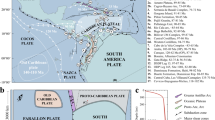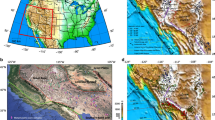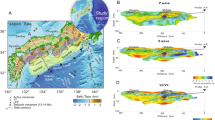Abstract
The building of the Andes results from the subduction of the oceanic Nazca plate underneath the South American continent1,2. However, how and why the Andes and their curvature, the Bolivian orocline, formed in the Cenozoic era (65.5 million years (Myr) ago to present), despite subduction continuing since the Mesozoic era3 (251.0–65.5 Myr ago), is still unknown. Three-dimensional numerical subduction models demonstrate that variations in slab thickness, arising from the Nazca plate’s age at the trench, produce a cordilleran morphology consistent with that observed1,2. The age-dependent sinking of the slab in the mantle drives traction towards the trench at the base of the upper plate, causing it to thicken. Thus, subducting older Nazca plate below the Central Andes can explain the locally thickened crust and higher elevations. Here we demonstrate that resultant thickening of the South American plate modifies both shear force gradients and migration rates along the trench to produce a concave margin that matches the Bolivian orocline. Additionally, the varying forcing along the margin allows stress belts to form in the upper-plate interior, explaining the widening of the Central Andes and the different tectonic styles found on their margins, the Eastern and Western Cordilleras2. The rise of the Central Andes and orocline formation are directly related to the local increase of Nazca plate age and an age distribution along the margin similar to that found today; the onset of these conditions only occurred in the Eocene epoch4. This may explain the enigmatic delay of the Andean orogeny, that is, the formation of the modern Andes.
This is a preview of subscription content, access via your institution
Access options
Subscribe to this journal
Receive 51 print issues and online access
$199.00 per year
only $3.90 per issue
Buy this article
- Purchase on Springer Link
- Instant access to full article PDF
Prices may be subject to local taxes which are calculated during checkout




Similar content being viewed by others
References
Isacks, B. L. Uplift of the central Andean plateau and bending of the Bolivian orocline. J. Geophys. Res. 93, 3211–3231 (1988)
Allmendinger, R. W., Jordan, T. E., Kay, S. M. & Isacks, B. L. The evolution of the Altiplano-Puna plateau of the central Andes. Annu. Rev. Earth Planet. Sci. 25, 139–174 (1997)
Mpodozis, C. & Ramos, V. A. in Geology of the Andes and its Relation to Hydrocarbon and Mineral Resources Vol. 11 (eds Ericksen, G. E., Cañas Pinochet, M. T. & Reinemud, J. A.). 59–90 (1990)
Sdrolias, M. & Müller, R. D. Controls on back-arc basin formation. Geochem. Geophys. Geosyst. 7 Q04016 10.1029/2005GC001090 (2006)
Arriagada, C., Roperch, P., Mpodozis, C. & Cobbold, P. Paleogene building of the Bolivian Orocline: tectonic restoration of the central Andes in 2-D map view. Tectonics 27 TC6014 10.1029/2008TC002269 (2008)
Allmendinger, R. W. & Gubbels, T. Pure and simple shear plateau uplift, Altiplano-Puna, Argentina and Bolivia. Tectonophysics 259, 1–13 (1996)
Gephart, J. W. Topography and subduction geometry in the central Andes: clues to the mechanics of a noncollisional orogen. J. Geophys. Res. 99 (B6). 12279–12288 (1994)
Jordan, T. E. et al. Andean tectonics related to geometry of subducted Nazca plate. Geol. Soc. Am. Bull. 94, 341–361 (1983)
Beck, S. L. & Zandt, G. The nature of orogenic crust in the central Andes. J. Geophys. Res. 107 (B10). 2230 10.1029/2000JB000124 (2002)
Gutscher, M. A., Spakman, W., Bijwaard, H. & Engdahl, E. R. Geodynamics of flat subduction: seismicity and tomographic constraints from the Andean margin. Tectonics 19, 814–833 (2000)
Schellart, W. P. et al. Evolution and diversity of subduction zones controlled by slab width. Nature 446, 308–311 (2007)
Allmendinger, R. W. et al. Bending the Bolivian orocline in real time. Geology 33, 905–908 (2005)
Yáñez, G. & Cembrano, J. Role of viscous plate coupling in the late Tertiary Andean tectonics. J. Geophys. Res. 109 B02407 10.1029/2003JB002494 (2004)
Lamb, S. & Davis, P. Cenozoic climate change as a possible cause for the rise of the Andes. Nature 425, 792–797 (2003)
Sobolev, S. V. & Babeyko, A. Y. What drives orogeny in the Andes? Geology 33, 617–620 (2005)
Iaffaldano, G. & Bunge, H. P. Strong plate coupling along the Nazca–South America convergent margin. Geology 36, 443–446 (2008)
Russo, R. M. & Silver, P. G. Cordillera formation, mantle dynamics, and the Wilson cycle. Geology 24, 511–514 (1996)
Wdowinski, S., O'Connell, R. J. & England, P. A continuum model of continental deformation above subduction zones: application to the Andes and the Aegean. J. Geophys. Res. 94 (B8). 10331–10346 (1989)
Husson, L. & Ricard, Y. Stress balance above subduction: application to the Andes. Earth Planet. Sci. Lett. 222, 1037–1050 (2004)
Pardo-Casas, F. & Molnar, P. Relative motions of the Nazca (Farallon) and South American plates since late Cretaceous time. Tectonics 6, 233–248 (1987)
Montgomery, D. R., Balco, G. & Willett, S. D. Climate, tectonics, and the morphology of the Andes. Geology 29, 579–582 (2001)
Capitanio, F. A., Stegman, D. R., Moresi, L. & Sharples, W. Upper plate controls on deep subduction, trench migrations and deformations at convergent margins. Tectonophysics 483, 80–92 (2010)
van Hunen, J., van der Berg, A. P. & Vlaar, N. J. On the role of subducting oceanic plateaus in the development of shallow flat subduction. Tectonophysics 352, 317–333 (2002)
Morra, G., Regenauer-Lieb, K. & Giardini, D. On the curvature of oceanic arcs. Geology 34, 877–880 (2006)
Kley, J. & Monaldi, C. R. Tectonic shortening and crustal thickness in the Central Andes: how good is the correlation? Geology 26, 723–726 (1998)
Gerbault, M., Martinod, J. & Hérail, G. Possible orogeny-parallel lower crustal flow and thickening in the Central Andes. Tectonophysics 399, 59–72 (2005)
Elger, K., Oncken, O. & Glodny, J. Plateau-style accumulation of deformation: Southern Altiplano. Tectonics 24 TC4020 10.1029/2004TC001675 (2005)
Garzione, C. N., Molnar, P., Libarkin, J. C. & MacFadden, B. J. Rapid late Miocene rise of the Bolivian Altiplano: evidence for removal of mantle lithosphere. Earth Planet. Sci. Lett. 241, 543–556 (2006)
DeMets, C., Gordon, R. G. & Argus, D. F. Geologically current plate motions. Geophys. J. Int. 181, 1–80 (2010)
Acknowledgements
We thank M. Faccenda, R. F. Weinberg and J. P. Brun for discussions. F.A.C. was supported by the Australian Research Council's Discovery Projects DP0987374. D.R.S. was supported in part by the G. Unger Vetlesen Foundation.
Author information
Authors and Affiliations
Contributions
F.A.C. designed and performed the numerical modelling. F.A.C. and S.Z. processed the models’ output and the data. All authors contributed to the writing of the paper.
Corresponding author
Ethics declarations
Competing interests
The authors declare no competing financial interests.
Supplementary information
Supplementary Information
The file contains Supplementary Methods and Data, Supplementary Figures 1-9 with legends, Supplementary Tables 1-2 and additional references. (PDF 19390 kb)
Rights and permissions
About this article
Cite this article
Capitanio, F., Faccenna, C., Zlotnik, S. et al. Subduction dynamics and the origin of Andean orogeny and the Bolivian orocline. Nature 480, 83–86 (2011). https://doi.org/10.1038/nature10596
Received:
Accepted:
Published:
Issue Date:
DOI: https://doi.org/10.1038/nature10596
This article is cited by
-
The Montecristo mining district, northern Chile: the relationship between vein-like magnetite-(apatite) and iron oxide-copper–gold deposits
Mineralium Deposita (2023)
-
3D geodynamic-geomorphologic modelling of deformation and exhumation at curved plate boundaries: Implications for the southern Alaskan plate corner
Scientific Reports (2022)
-
Rapid surface uplift and crustal flow in the Central Andes (southern Peru) controlled by lithospheric drip dynamics
Scientific Reports (2022)
-
Variations of yields and molecular and isotopic compositions in gases generated from Miocene strata of the Carpathian Foredeep (Poland) as determined by hydrous pyrolysis
International Journal of Earth Sciences (2022)
-
Southward expanding plate coupling due to variation in sediment subduction as a cause of Andean growth
Nature Communications (2021)
Comments
By submitting a comment you agree to abide by our Terms and Community Guidelines. If you find something abusive or that does not comply with our terms or guidelines please flag it as inappropriate.



